Modern Bathroom Tile Design: Trends 2024/25
Bathroom tile design: trends and fresh interior ideas
Ceramic tiles are a favored material for bathroom and toilet cladding due to their suitability for high-humidity environments. The design possibilities for bathroom tiles are vast. We can explore the diverse range of ceramics, their selection features in terms of functionality and aesthetics, and conclude with intriguing ideas and current trends in interior design.
What is important to know about tile design
Designers offer tiles of any colors, shapes, sizes, with an imitation of a variety of textures.
- Imitation of the material. Tiles can repeat the texture of marble, wood, metal, onyx, terrazzo, concrete, leather, textiles, etc.
- Color. Warm shades create coziness, energize, cold ones calm down, tune in to relaxation.
Monocolor, or monochromatic coloring, is one of the most popular. It is especially advantageous in combination with natural textures. - Decor. Ornaments and patterns allow you to diversify a monochromatic surface, make accents, and zone the space.
- Surface type: glossy or matte. A glossy coating reflects light, visually expands the space, matte is more practical and easier to care for.
- Format. Manufacturers offer different sizes: 40×40, 30×60, 20×60 cm, etc.
- Invoice. Tiles can be smooth or textured – with an imitation of masonry, décor from wind.
Tip: Select a coating in person rather than from a photograph. Even the highest quality image cannot capture all the subtle details. The glossy layer must be flawless, free of cracks, roughness, or any imperfections. Consider the pattern variability within a single pack or collection—the face of the tile. The greater the diversity of the graphics, the more authentic the surface will appear, particularly for imitating natural materials.
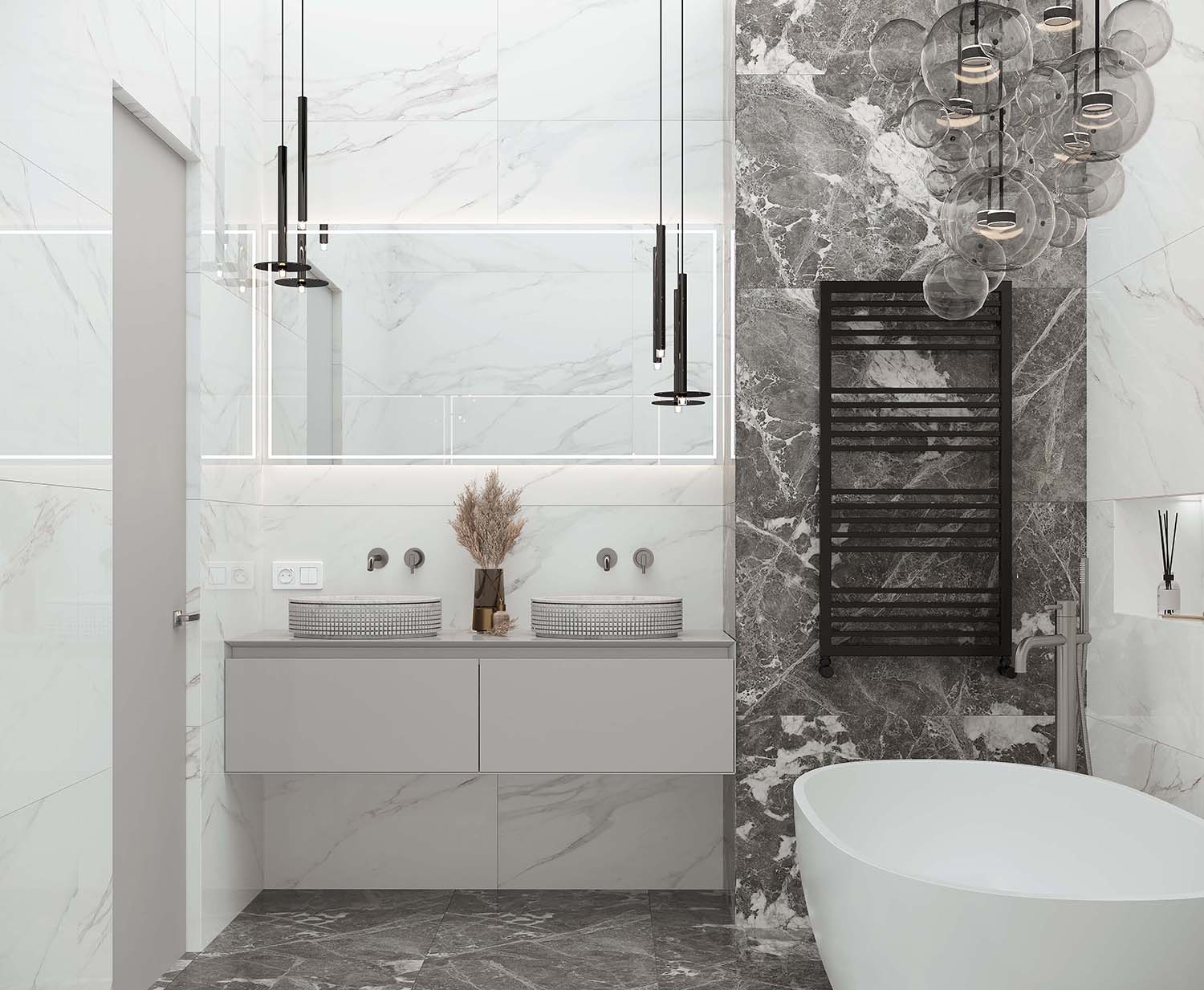
Pros and cons of tiles
The bathroom, a room subject to high humidity and frequent temperature fluctuations, demands careful selection of coatings. These should be moisture-resistant, long-lasting, straightforward to install, and require minimal maintenance. Beyond its primary function for hygiene, the bathroom serves a psychological role as well. It’s a personal retreat for solitude and unwinding, a place to rejuvenate and shake off the day’s stress. Hence, the ambiance should be not just practical, but also serene and inviting.
It is very important to choose the right cladding material: hygienic, moisture and heat resistant, and at the same time beautiful and modern. Manufacturers offer many coatings, among which ceramic tiles are, if not the best, then one of the leaders. But, like any material, it has its pros and cons. Let’s talk about the advantages and disadvantages of bathroom tiling – about design from a practical point of view.
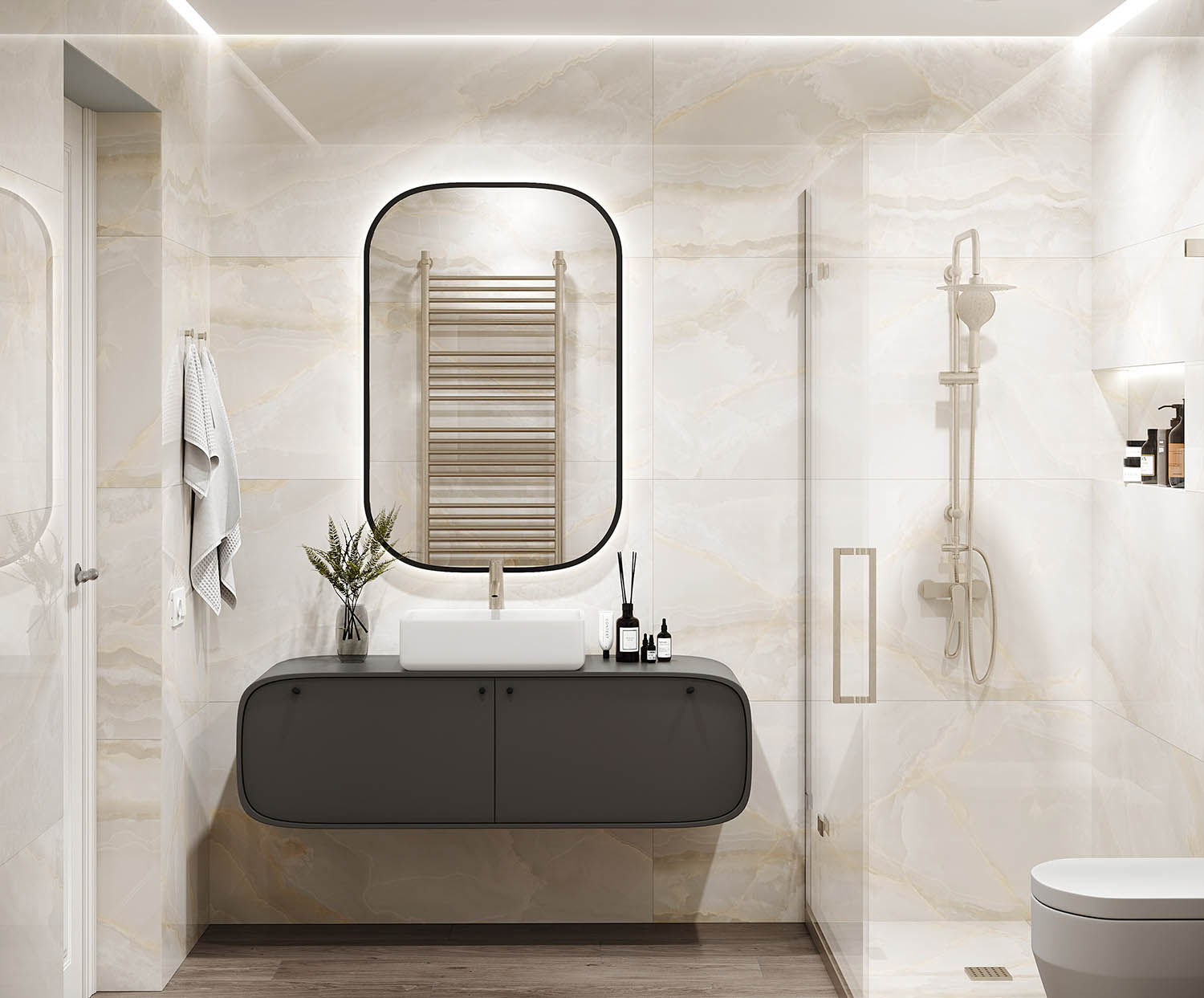
Advantages
- Moisture resistance. Here, tiles have no equal – they can easily withstand constant exposure to moisture.
- Hygienic. Tiles do not absorb odors, are not a medium for the reproduction of fungi and microorganisms.
- Fire safety. Ceramics do not burn or melt, and are resistant to high temperatures and open flames.
- Electrical insulation. The material does not conduct electric current, it is safe for rooms with working electrical appliances: washing machine, hair dryer, iron, etc.
- Easy to care for. Any cleaning methods and detergents are used – they do not spoil the ceramics.
- Strength and durability. The tiles will last for more than one decade, maintaining a beautiful and neat appearance.
- Harmless, environmentally friendly. For the manufacture, only natural raw materials are taken, which are fired, giving strength and water resistance.
- A large selection of colors and patterns, affordable cost. It is possible to implement almost any projects in terms of complexity and price requests.
The most budget option is classic white tiles. But even such a simple solution opens up incredible scope for imagination with extraordinary installation and skillful decoration.
If you want to create a unique and mesmerizing design, it can be an original panel, marble or natural stone finishes, decorative accents made of silver and gold. See how luxurious the mosaics in graphite and brown from the Ferry collection look.
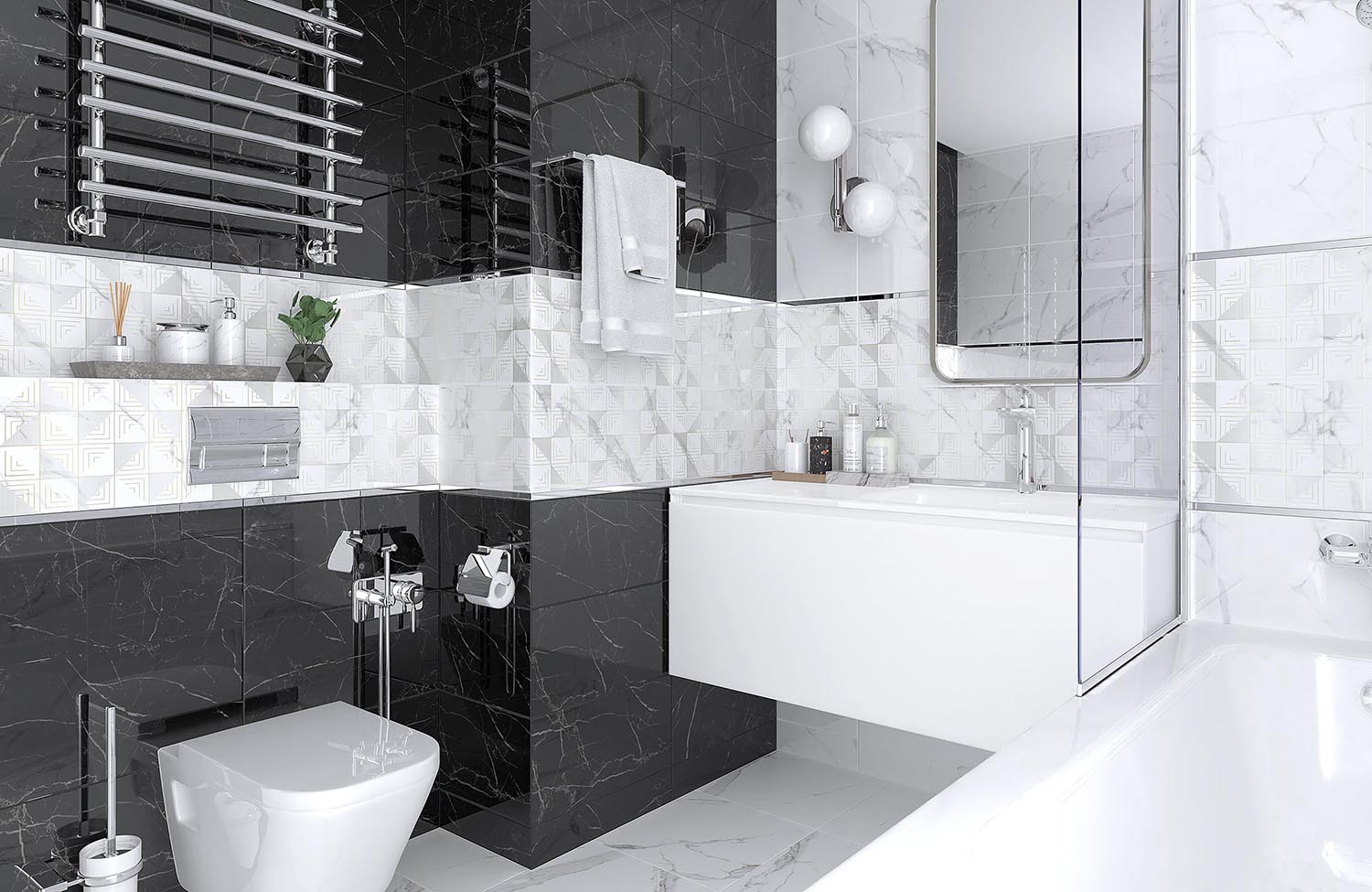
Disadvantages
- Complexity of installation. Before cladding, you need to perfectly align the wall. The master must be experienced and skillful, as even the slightest mistakes and irregularities will spoil the whole look. You should work carefully, avoiding chips, scratches and cracks.
- Slippery and cold floor. To solve the problem, a safe anti-slip floor covering is chosen, rubberized mats are laid on top. Underfloor heating is also made.
- Inter-tile joints. Dust, dirt, fungus and microbes accumulate in them. Not only does it look untidy, but it’s also unhealthy. Regular cleaning and prevention using special products will help.
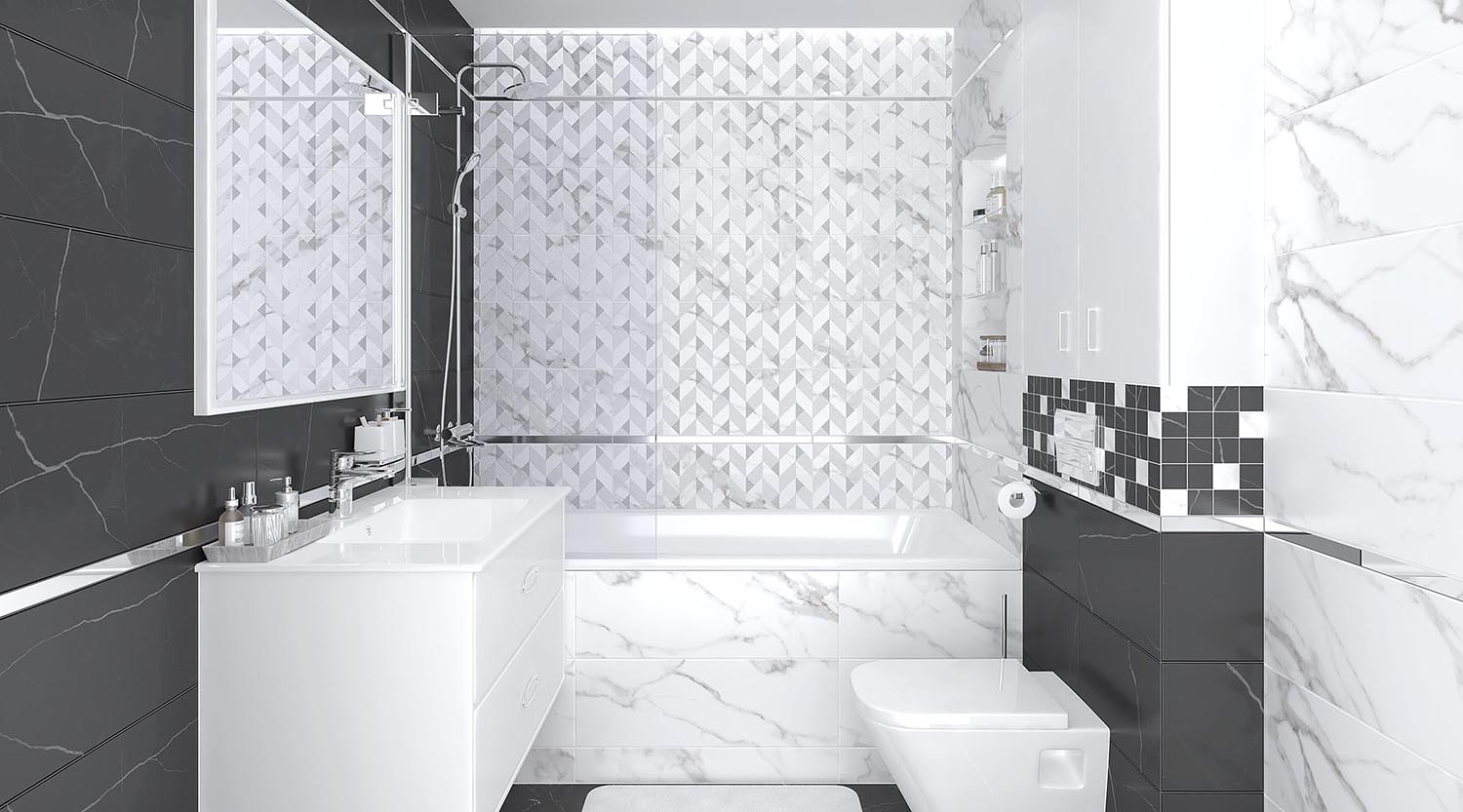
Types of tiles
To create a cozy atmosphere in the bathroom, it is important to choose the right ceramics. It is produced using several technologies, from different types of clay, with the addition of fillers: sand, alabaster, minerals, etc.
The main varieties of ceramic tiles:
- Faience is light, made of white clay.
- Majolica is porous ceramics made of red clay, glaze is applied to it.
- Cotto is unglazed ceramics, undergoes one firing cycle.
- Cottoforte – a mixture of several types of clay is subjected to double firing (gives it increased strength) and is covered with an opaque glaze.
- Mettlakh is made from a refractory porcelain mixture, undergoes high-temperature firing, and is glazed on top.
Porcelain stoneware deserves special mention as a robust and hardy surfacing material that replicates natural textures. The clay is compressed under high temperatures, with color permeating the entire body, not just the surface. These slabs are used for both flooring and wall cladding. They withstand mechanical and thermal stress, as well as high moisture levels. Porcelain stoneware comes in polished, textured, glazed, or unglazed finishes.
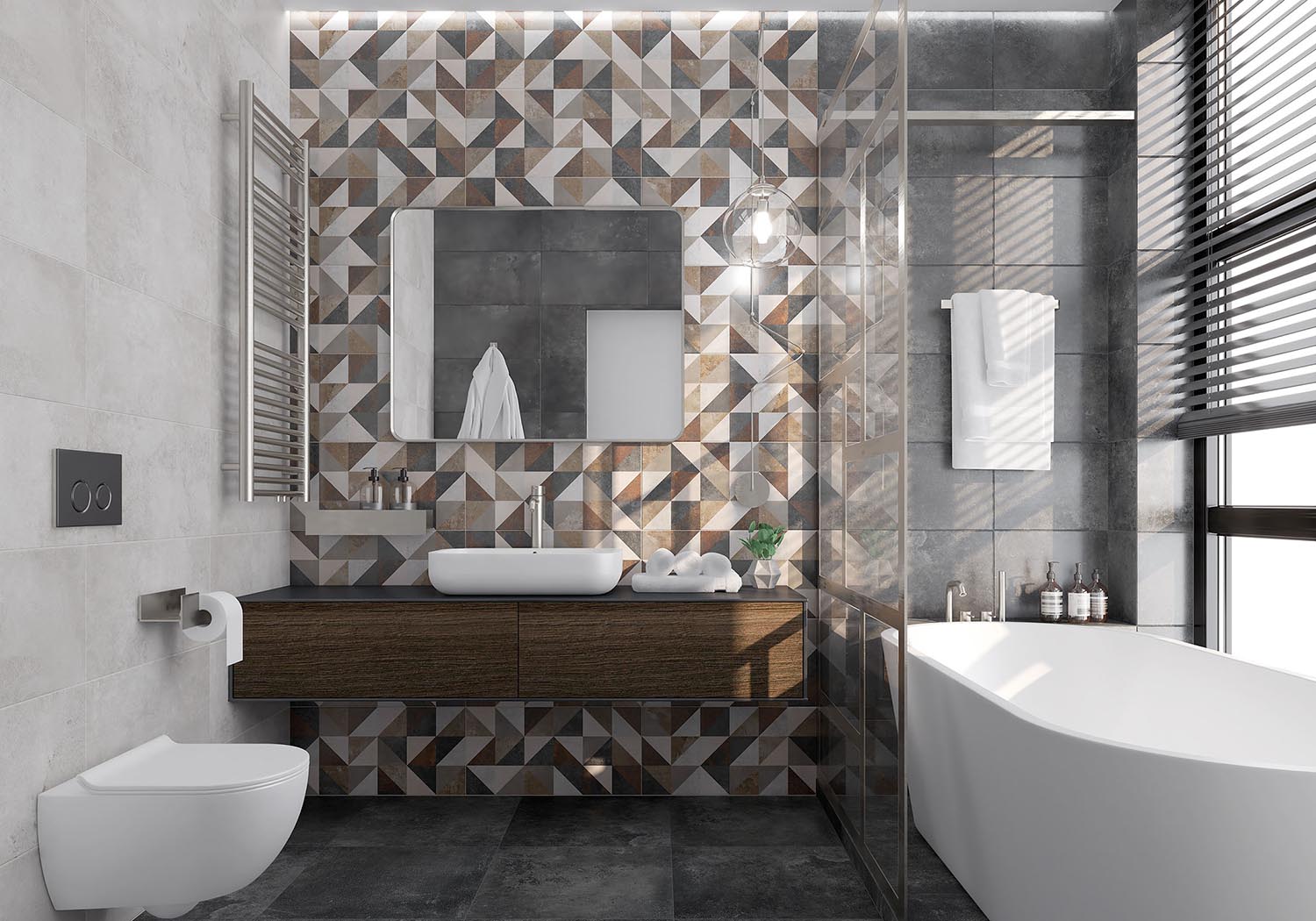
Modern bathroom tile design: trends 2024/25
While decoration is not limited to a single season, it’s still crucial to consider current fashion trends. Discussing the hot trends that will remain relevant in the upcoming years, such as ceramic panels, pixel art, complex color palettes, and high styling, it’s important to discern which are at the height of popularity and which ones to forgo.
Let’s start with the trends:
- Gloss is especially relevant for small bathrooms. The shiny surface looks grand and pompous, creates a feeling of spaciousness. Today, it is fashionable to combine glossy and matte coatings. Shine and glare are good for both classic and democratic interiors. However, they are completely out of place in eco, Scandi, and minimalism.
- Dark palette: graphite, brown, brown, burgundy, wenge, even blue-black. The walls, ceiling and floor can be designed in the same color. Or they are made contrasting, highlighting certain areas with light tiles. A wood or marble coating with bright veins will be appropriate here. To avoid being completely gloomy, fill the room with light – more glass, mirrors, gloss.
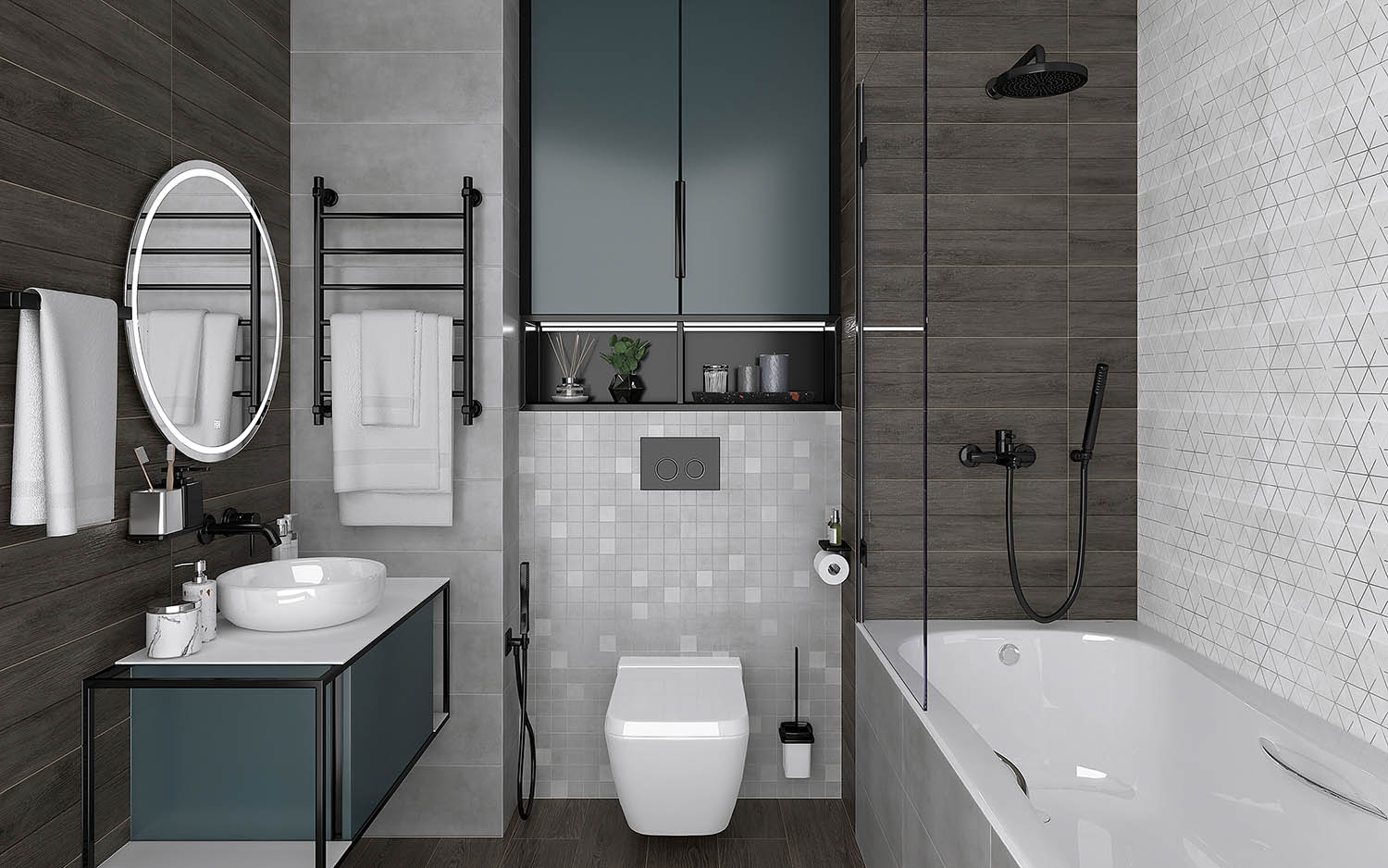
- Imitation of stone. Granite, onyx, agate are excellent alternatives to traditional marble. For eco-style, porcelain stoneware with the texture of small pebbles and inclusions of slate will be a good solution. For lovers of contrasts, we offer the Agat collection: a mesmerizing agate pattern and a sophisticated gray-coffee palette look non-trivial and laconic. The luxurious and whimsical onyx pattern is reproduced in the Sirius Gold design collection. If you choose a marble texture, let it be something fresh, dynamic: contrasting veins, bold color combinations. For example, the original smoky blue Eden tiles with a delicate golden décor. It reminds you of the endless sky on a clear summer day, sets you up for a calm, serene mood.
- The wood-effect board fits into the trend of naturalness. Options with traced branches are considered especially fashionable. Take a look at the Village tiles with a pleasant wood texture that recreates the warmth and cosiness of a country house. There are two ranges: beige-brown and black and white graphite.
- Drawing, panel. Tiles do not always have to be monochromatic or with a repetitive ornament – the pattern can also be asymmetrical, plotted. Panels of medium or small elements look interesting. However, keep in mind that such finishing takes a lot of attention. It should be used sparingly so as not to ripple in the eyes. When thinking over the design of a bathroom with a tile shower, you can visually highlight one functional area – near the shower or sink. Use a decophone – a slab with a pattern or ornament. A non-standard solution is the botanical pattern from the Focus collection. It will refresh and diversify the interior in the spirit of classics, contemporary, eco or fusion.
- Beige is a universal color that is again held in high esteem. It feels warm, soft, enveloping. If you want more comfort, use a natural palette. Give preference to brown, gray colors. Combine them with natural textures: sand, stone, wood. The beige tone can be emphasized with exquisite gold, as in the Fronda collection – such a coating will fill the room with light and will look harmonious with wooden furniture.
- Rectangular and square shape. The simpler the better. This also applies to the layout: it should be standard. If you need to visually stretch the room upwards, use rectangles with a vertical layout.
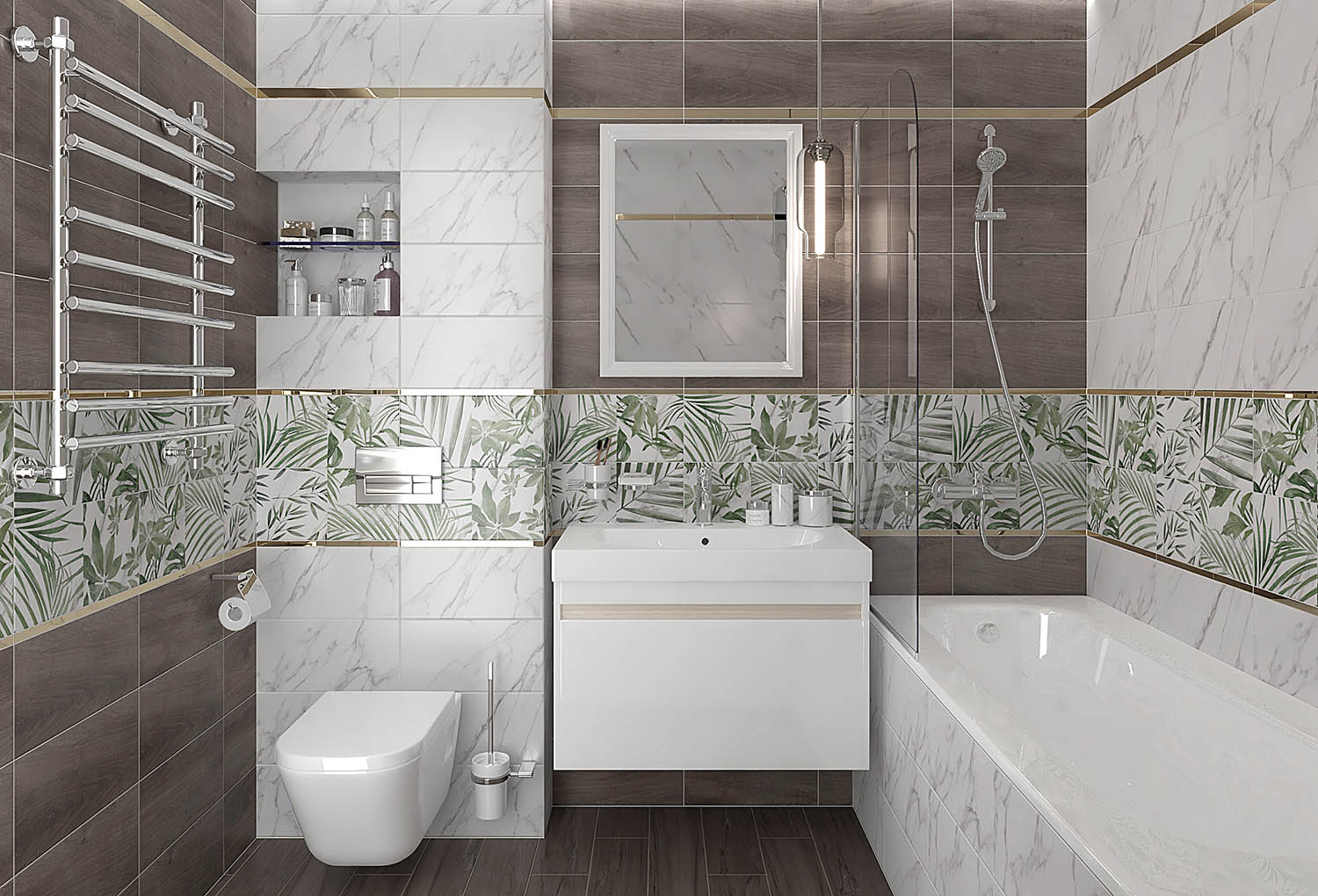
- Honeycomb. Compared to simple shapes, hexagons, although losing ground, are still in trend. Such cladding is appropriate both on the walls and on the floor. It can be a monochromatic coating, or a layout in the form of an ornament. White, gray and beige shades look fresh and relevant.
- Deep complex tones: malachite, wine, coniferous, oceanic blue, eggplant, brick, etc. Color becomes the main visual accent, complex décor is superfluous here. Such tones add drama, so they can be diluted with a neutral black and white palette. In these cases, noble textures are selected: marble, stone, wood, metal, etc.
- Pixel tiles allow you to place accents and highlight zones. The main area remains monochromatic. Combinations of brown and beige, black-and-white and gray pixels with the main light background look beautiful and unusual. The Mizar pixel pseudo-mosaic, made in stylish gray tones, will perfectly fit into the urban interior.
- Embossed textures. They bring variety, allow you to visually highlight individual areas. Betting on the relief, choose gray or white for the walls, dark blue for the floor.
- Chameleon effect. Such tiles can cover the entire area or area near the sink, shower cabin or toilet. The coating looks original and stylish, but in this case it is important to choose the right pattern.
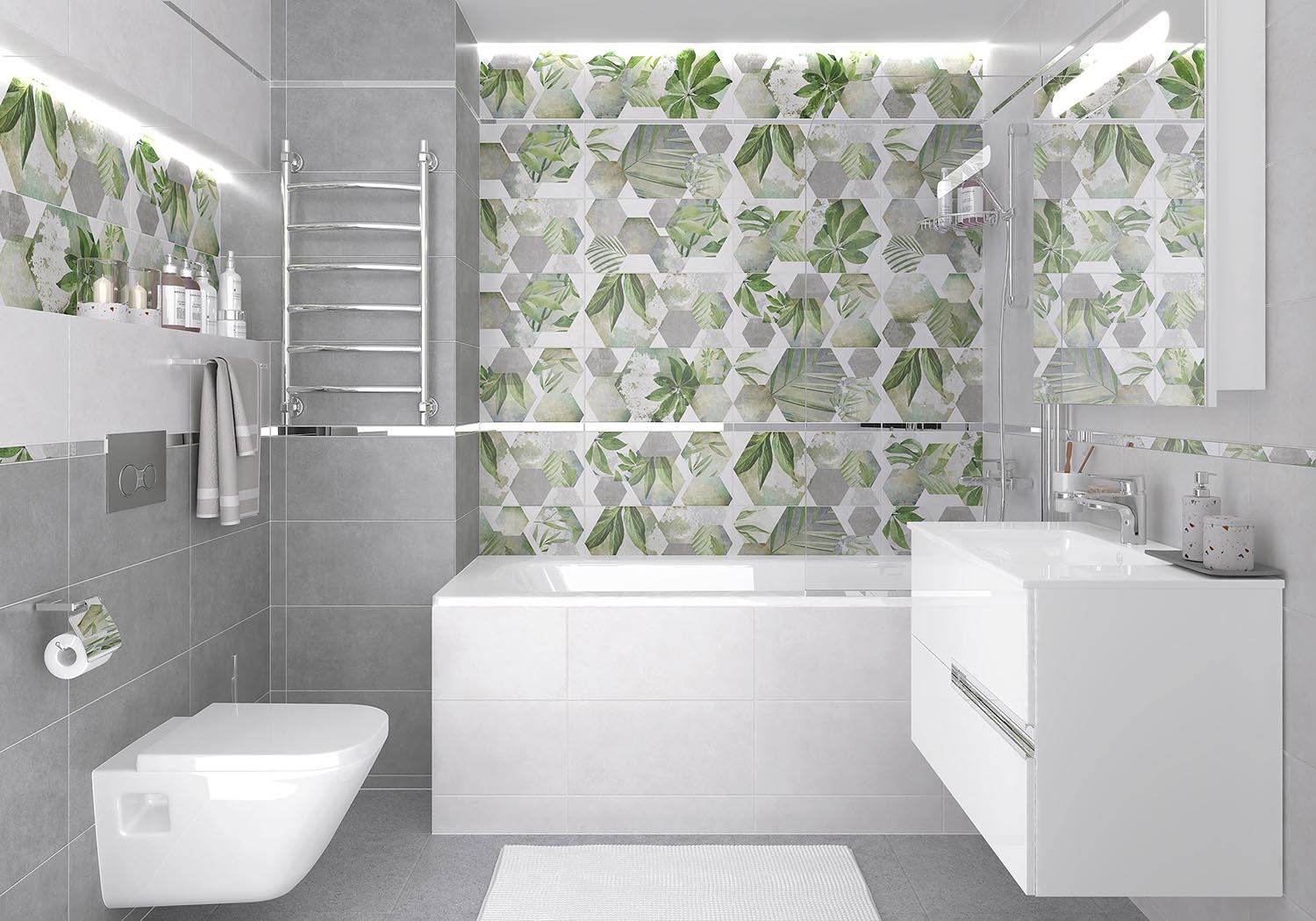
Anti-trends: what is better to say goodbye to
Fashion in decoration does not change as rapidly as in décor, but still there are trends here. Some solutions become relevant, others become a thing of the past. So, what is already considered obsolete?
- Schematic mosaic. Once it was fashionable to lay out a pattern from small tiles, as for cross-stitch. Today this is an anti-trend. Small squares stacked in a checkerboard pattern are also yesterday. If you still decide to make a mosaic, let it be a small area, a narrow partition. Choose colors to match, without variety. A harmonious combination is wavy coffee tiles for the main square and darker mosaics, for example, chocolate with golden inclusions. But still, for cramped bathrooms, small squares are not the best solution.
- “Boar”, “herringbone”, brickwork – all these methods of layout have recently been very popular. So much so that they managed to get bored, and now designers are looking for alternative options.
- Continuous layout, when all surfaces are faced in the same way. It is much more interesting to make combinations: porcelain stoneware, plaster, paint, moisture-resistant wallpaper, decorative panels. Even if it is solid ceramics, let it be multi-colored, with a variety of reliefs.
- Light top, dark bottom. It is not necessary to adhere to this “pioneer” rule. Experiment, break the canons: make the walls dark, and put snow-white tiles on the floor. Choose a coating to match the tone or play on contrasts, try delicate pastel shades or deep, bright, saturated. For a contrasting interior in a strict monochrome palette, the Granada collection is ideal.
Some of the previous options are returning. They can fit into the style of minimalism or Scandi, contemporary, loft. For example, imitation of brickwork is not considered so relevant, but in some cases it looks organic. You can decorate one of the walls in this way. In order not to turn out too old-fashioned, bet on white and coffee tones.
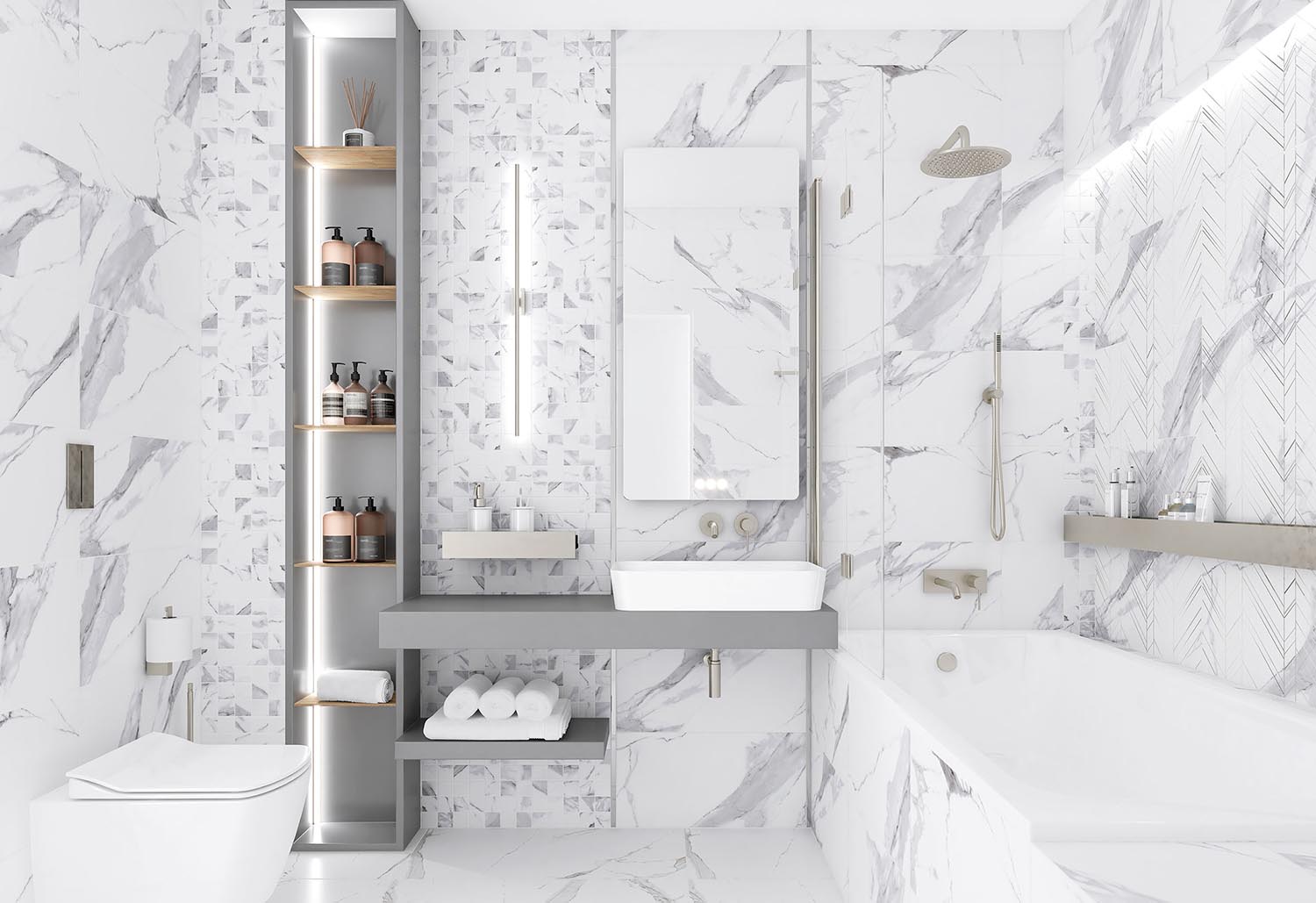
Being trendy is not about mindlessly following patterns. We’ve curated the most pertinent ideas that you can adopt if you wish. Foremost are your personal preferences and expectations. Consider the ambiance you wish to create; the possibilities are numerous: cozy home comfort, soft romance, ostentatious luxury, or sleek high-tech, among others. The characteristics of the room are equally crucial: its size, ceiling height, layout, and plumbing setup. Cladding can be used to transform the space, making the bathroom appear larger, unifying disparate elements, and accentuating functional zones. The diversity in shapes, colors, and textures enables the realization of any project, no matter how unconventional.






